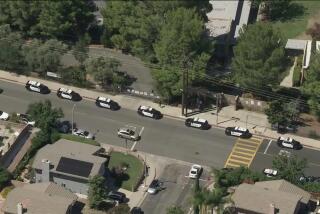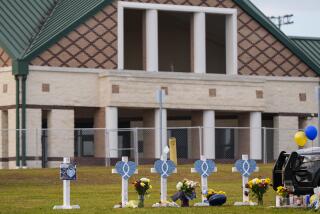Ten months after the Florida school shooting, what’s being done to prevent another tragedy?
- Share via
Reporting from Fort Lauderdale, Fla. — Once he decided to shoot up a school, there wasn’t much to stop Nikolas Cruz.
His threats were ignored, the campus was wide open, the school doors were unlocked and students had nowhere to hide.
What has changed?
Though 10 months have passed since the mass shooting at Marjory Stoneman Douglas High School in Parkland, Fla., students in Broward County are still exposed to potential danger. At least a quarter of campuses don’t have single entry points to control intruders. Safe spaces to protect children in classrooms haven’t been identified. There’s no policy outlining how to respond to an active shooter.
Even seemingly simple things — like making sure each classroom has a place where students can hide from bullets — have not been done.
The district points to some major security enhancements, including $6.2 million in new security cameras, $4.5 million for portable radios and $17 million for upgrades to intercom systems.
But some projects that are underway — like making sure an intruder can’t walk into an unlocked school and shoot people — are already behind schedule.
Here’s a look at critical failures that led to the slayings of 17 staff members and students, and the status of remedies to keep such a tragedy from happening again.
Breaching the campus
Nikolas Cruz was known by former classmates and even some administrators as a potential school shooter. And still he walked right onto campus.
The intrusion led to calls for locked gates, locked doors, mandatory ID cards, see-through backpacks and metal detectors. Some of that is moving forward for all Broward schools. Some, like clear backpacks and metal detectors, were nixed early on.
More than a quarter of Broward County’s 238 public schools still aren’t capable of funneling guests through one entry point. On some campuses, a stranger could roam and might be able to walk into a building when a door opens.
These issues were supposed to be fixed as part of an $800-million bond referendum passed by Broward County voters in 2014. After the Stoneman Douglas shooting, Supt. Robert Runcie said that he would expedite the single-point-of-entry retrofits and that all campuses would be secure by early 2019.
That’s not going to happen, district officials now say. Most retrofits are expected to be completed by March, but about two dozen will be delayed until later in the year or 2020, construction officials told the school board this month.
Hard corners
Some children died at Stoneman Douglas because they had nowhere to hide.
The district had not mandated safe areas known as “hard corners” — spots that a gunman shooting through a doorway would not see. As a result, those possible safety zones were not marked or were blocked by desks, bookcases or other obstacles.
The school district has yet to fix the problem.
“Is there any reason why tomorrow there’s not a hard corner in every classroom in every school in the district?” asked James Harpring, undersheriff for the Indian River County Sheriff’s Office and a member of the Marjory Stoneman Douglas Public Safety Commission. “A hard corner is immediate, doesn’t cost anything and is an immediate lifesaving action that can take place.”
Said Andy Pollack, whose 18-year-old daughter, Meadow, was killed in the shooting: “They can’t figure out how to put a piece of tape across the corner of the room? It’s ridiculous.”
Runcie said he will begin implementing the change after the winter break and make adjustments later. “I think we need to do something on an expedited basis,” he said.
Doors and windows
When it came to protecting students at Stoneman Douglas, the doors and windows made the school even more unsafe.
Bathroom doors were kept locked due to drug and vaping problems, and that prevented victims Joaquin Oliver and Meadow Pollack from finding a safe hiding place. The school district has directed schools not to lock restrooms anymore.
Another issue that further endangered children as Cruz shot up the school on Feb. 14: Classroom doors could be locked only from the outside with a key, giving teachers the awful choice of standing out in the line of fire or leaving their classroom doors unsecured.
The district has since replaced the locking hardware at Stoneman Douglas. The doors now work like an emergency exit door — they always can be opened from the inside but are always locked from the outside. However, most other schools still have the old doors that must be locked from the outside with a key.
Cruz never entered a classroom but identified targets by looking through the windows on the doors and then shooting through them.
So far, one school, Heron Heights Elementary, has bullet-resistant glass on its windows. The windows and their installation were donated by Ballistiglass, a Broward County company whose president is a parent at the school.
School district officials have no immediate plans to replicate this districtwide unless they can get more donations or funding.
Metal detectors
Cruz intruded with his weapon in tote, and surveillance cameras caught the horrifying image of him aiming an assault rifle inside a school full of children.
The intrusion sparked discussion of metal detectors. Donors in the community offered to give metal detectors to Stoneman Douglas High, and they were to be installed by the first day of school in the fall.
But the school district pulled the plug and has no plans for metal detectors in Broward schools, on the advice of Safe Havens International, the security firm the district hired to review its schools.
Metal detectors are expensive — about $1 million a school for equipment and staffing — and have only about a 70% success rate, said Michael Dorn, executive director of Safe Havens.
Still, the state’s Stoneman Douglas commission said that metal detectors and X-ray machines should be considered at campus entrances.
Heeding the warnings
Cruz’s lust for violence had been documented officially 69 times in his life. At least 30 people knew of his troubling behavior before the shooting.
Experts say threat assessments — recognizing troubling signs, assessing the student and acting on the risk — are one of the most effective ways to shut down potential shootings. Broward’s school threat assessment process needs immediate improvement, a recent consultant’s report said.
At Stoneman Douglas High, Principal Ty Thompson was not involved in threat assessments. Assistant Principal Jeff Morford performed his first one ever on Cruz, couldn’t remember any details and ignored warnings about potential danger, the Stoneman Douglas commission found.
Supt. Runcie said he hired a consultant to look at how threat assessments have been conducted in Broward schools. That review is underway. A new state law requires all schools to have a threat assessment team that includes a school administrator.
The state commission recommended that all suspicious student behavior be reported to an administrator and documented, and that all threats of school violence be reported to the principal or higher. When asked Saturday, spokeswoman Kathy Koch said she could not immediately say whether the district would adopt the recommendations.
Security guards
Cruz didn’t slip past security to enter the school. He was spotted immediately by a campus security monitor who recognized him as “Crazy Boy” and noticed he was carrying a rifle bag.
The school also had an armed deputy.
Neither helped.
Still, a new Parkland-inspired state law, the Marjory Stoneman Douglas High School Public Safety Act, requires armed security at every public school in Florida.
Most of the district’s 238 schools use police officers from local cities or the Broward County Sheriff’s Office, with the school district subsidizing some of the costs. However, local cities are not paying for school police officers in about 50 schools, mostly elementary, so the school district provides these with “guardians,” or armed school district employees who can carry a gun.
The school district started training these employees through the Sheriff’s Office in late summer and paid off-duty police officers to fill in at schools until the guardians were ready to go to schools.
Right now, the district has 43 guardians and expects by early 2019 to be fully staffed to cover all 50 schools, with more to be hired for backup, Runcie said. The district also has 16 of its own police detectives who cover schools as needed.
Red alert
When Cruz started shooting, no one at Marjory Stoneman Douglas called a “Code Red,” ordering people to take cover behind locked doors, until the assault had been underway for three minutes.
Staff were unprepared to know precisely how and when to order a lockdown, and some people died as a result, the Stoneman Douglas commission found. “There was no policy, little training and no drills,” the panel reported.
Since the shooting, the state has mandated Code Red drills for all schools. In Broward County they are being conducted monthly. The county school board is considering an official policy, spelling out that anyone can call a Code Red if they see or hear anything that immediately threatens safety.
‘Several missed opportunities’
In late 2013, Broward’s top school and law enforcement leaders signed an agreement to refrain, whenever possible, from arresting and expelling children, because too many black youths were being kicked out of school or jailed while white students were not for similar misdeeds.
Cruz was never arrested, though the Stoneman Douglas commission found there “were several missed opportunities” at home and at school to arrest him.
Runcie has ordered audits of school discipline and will have a “zero-tolerance policy” for administrators who give the improper punishment to students, he said.
Cruz made several nonspecific threats on social media to shoot up a school. Under the new state law enacted after the Parkland shooting, such postings are now considered second-degree felonies.
“By not arresting Cruz the judicial system did not have an opportunity to identify and address his systemic and troubling behavior,” the Stoneman Douglas commission determined.
A drawn-out process
The district had each school evaluated by Safe Havens International to meet the requirements of the new state law. The work to make the campuses safe isn’t going to be quick, though.
“Many of our buildings were designed and constructed at a time when schools were not targets for the violence we are currently witnessing,” Broward school administrator Valerie Wanza told principals in a memo March 5. “We must continue to be vigilant by addressing the most apparent risks first, while planning for long-term strategies.”
Members of the Stoneman Douglas commission are tired of waiting on Broward schools to act. Commissioner Melissa Larkin-Skinner was seething at a meeting Dec. 12.
“I am extremely dismayed that the people around this table … seem to be taking this much more seriously than the officials at Broward County,” said Larkin-Skinner, a Manatee County hospital chief executive. “It actually makes me physically ill. I would think that ground zero for this massacre would want to be ahead of the rest of the state.”
Wallman, Travis and O’Matz write for the South Florida Sun Sentinel.
More to Read
Sign up for Essential California
The most important California stories and recommendations in your inbox every morning.
You may occasionally receive promotional content from the Los Angeles Times.










